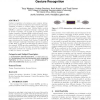64 search results - page 4 / 13 » American Sign Language Recognition Using Multi-dimensional H... |
FGR
2006
IEEE
14 years 1 months ago
2006
IEEE
We present a novel tracking algorithm that uses dynamic programming to determine the path of target objects and that is able to track an arbitrary number of different objects. The...
WACV
2005
IEEE
14 years 1 months ago
2005
IEEE
This paper presents an automatic Australian sign language (Auslan) recognition system, which tracks multiple target objects (the face and hands) throughout an image sequence and e...
DAGM
2005
Springer
14 years 1 months ago
2005
Springer
In this paper, we employ a zero-order local deformation model to model the visual variability of video streams of American sign language (ASL) words. We discuss two possible ways o...
ICMI
2003
Springer
14 years 29 days ago
2003
Springer
Gesture recognition is becoming a more common interaction tool in the fields of ubiquitous and wearable computing. Designing a system to perform gesture recognition, however, can...
GW
2007
Springer
14 years 1 months ago
2007
Springer
Abstract. This work aims to recognize signs which have both manual and nonmanual components by providing a sequential belief-based fusion mechanism. We propose a methodology based ...

